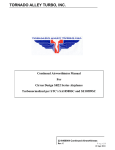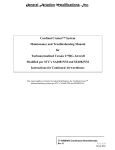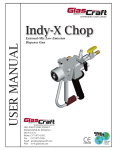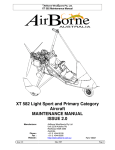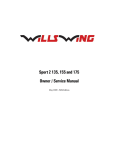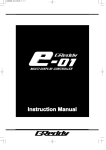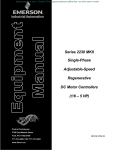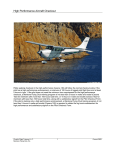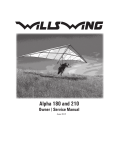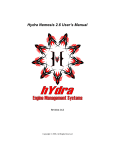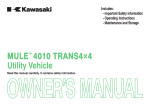Download Tornado Alley Maintenance Manual
Transcript
MAINTENANCE MANUAL with TROUBLE SHOOTING MANUAL For the TURBONORMALIZED CIRRUS DESIGN SR22 Series Airplane L/H INTERCOOLER SCAVENGE PUMP UPPER DECK REFERENCE MP CONTROLLER FUEL MANIFOLD VALVE PRESSURE RELIEF VALVE FIREWALL FUEL PUMP HEATER BOX, HEATER VALVE WASTEGATE ACTUATOR TURBO L/H TAILPIPE Tornado Alley Turbo, Inc. 400 Airport Road Ada, OK 74820 FAA APPROVAL HAS BEEN OBTAINED ON THE TECHNICAL DATA IN THIS PUBLICATION THAT AFFECTS AIRPLANE TYPE DESIGN. COPYRIGHT 2006 TORNADO ALLEY TURBO, INC. ADA, OKLAHOMA USA P/N Report 215-10 ISSUED Nov, 2006 TORNADO ALLEY INC . LIST OF EFFECTIVE PAGES Part REPORT 215-10-LOEP Page 1 Date 08 NOV 2006 REPORT 215-10-LOEP 2 08 NOV 2006 REPORT 215-10-TOC 1 08 NOV 2006 REPORT 215-10-TOC 2 08 NOV 2006 REPORT 215-10 1 08 NOV 2006 REPORT 215-10 2 08 NOV 2006 REPORT 215-10 3 08 NOV 2006 REPORT 215-10 4 08 NOV 2006 REPORT 215-10 5 08 NOV 2006 REPORT 215-10 6 08 NOV 2006 REPORT 215-10 7 08 NOV 2006 REPORT 215-10 8 08 NOV 2006 REPORT 215-10 9 08 NOV 2006 REPORT 215-10 10 08 NOV 2006 REPORT 215-10 11 08 NOV 2006 REPORT 215-10 12 08 NOV 2006 REPORT 215-10 13 08 NOV 2006 REPORT 215-10 14 08 NOV 2006 REPORT 215-10 15 08 NOV 2006 REPORT 215-10 16 08 NOV 2006 REPORT 215-10 17 08 NOV 2006 REPORT 215-10 18 08 NOV 2006 REPORT 215-10 19 08 NOV 2006 REPORT 215-10 20 08 NOV 2006 REPORT 215-10 21 08 NOV 2006 REPORT 215-10 22 08 NOV 2006 REPORT 215-10 23 08 NOV 2006 REPORT 215-10 24 08 NOV 2006 EFFECTIVITY: Report 215-10-LOEP Page 1 08 Nov 2006 TORNADO ALLEY INC . Intentionally Left Blank Report 215-10-LOEP Page 2 08 Nov 2006 EFFECTIVITY: All TORNADO ALLEY INC . TABLE OF CONTENTS Subject Page AIRWORTHINESS LIMITATIONS There are no limiting inspections and/or maintenance items. 1 DESCRIPTION AND OPERATION Alternate Air Door 2 TROUBLESHOOTING Momentary Overshoot Of Manifold Pressure 4 MAINTENANCE PRACTICES Time Limits And Maintenance Checks 9 Overhaul And Replacement Schedule 9 Scheduled Maintenance Checks 9 Progressive Inspection Program 11 Turbonormalizers 13 Absolute Controller 13 Removal and Installation -Absolute Controller Adjustment - Absolute Controller Master Waste Gate Actuator 14 14 14 Removal and Installation -Master Waste Gate Actuator 14 Adjustment - Master Waste Gate Actuator 15 Slave Waste Gate Removal And Installation Of Slave Waste Gate Pressure Relief Valve Removal And Installation Of Pressure Relief Valve Engine 15 15 15 15 15 Removal and Overhaul - Engine 15 Installation - Engine 16 Inspection - Post Engine Overhaul / Installation 16 Servicing - Post Engine Overhaul / Installation 17 Adjustments - Post Engine Overhaul / Installation 18 Operational Inspection - First Flight Run-Up 19 Functional Inspection - Return to Service Flight 19 EFFECTIVITY: Report 215-10-TOC Page 1 08 Nov 2006 TORNADO ALLEY INC . Intentionally Left Blank Report 215-10-TOC Page 2 08 Nov 2006 EFFECTIVITY: All TORNADO ALLEY INC . AIRWORTHINESS LIMITATIONS The Airworthiness Limitations Section is and specifies inspection and maintenance required under paragraphs 43.16 and 91.403 of the Federal Aviation Regulations unless an alternative program has been. A. There are no limiting inspections and/or maintenance items. EFFECTIVITY: All Report 215-10 Page 1 08 Nov 2006 TORNADO ALLEY INC . DESCRIPTION AND OPERATION The Tornado Alley Turbonormalizing System (See Figure Report 215-10-1) utilizes two Kelly Aerospace turbonormalizers with a Kelly absolute manifold pressure controller, and a Kelly pressure relief valve. The turbonormalizers are new generation turbonormalizers designed to provide the same boost as older design turbonormalizers but with lower compressor discharge temperatures. This increase in efficiency is due to the improved design of the compressor blades and compressor housing. However, to further reduce engine induction temperatures, two side baffle mounted intercoolers are also installed in the system. The absolute controller and wastegates work in conjunction with each other to provide proper boost pressure to the engine. The wastegate is actuated using engine oil pressure to actuate a small hydraulic cylinder which redirects the engine by-pass exhaust flow around the turbonormalizers. The absolute pressure controller utilizes an aneroid bellows and spring connected to a valve that regulates the amount of oil flowing out of the wastegate actuator hydraulic control cylinder. The aneroid bellows are located inside a housing that is connected to the output air produced by the compressors. As compressor outlet pressure increases, the bellows are forced down, opening the normally closed oil control valve. When open, the valve allows metered oil to bypass the wastegate which, in turn, is spring loaded to the open position. Oil passing through the absolute controller is returned to the engine oil sump. The left hand wastegate is a master wastegate connected to a slave wastegate on the right side of the engine. The right hand wastegate is the same as the left hand wastegate, but is slaved to the hydraulic actuator on the left hand wastegate. The two wastegates are mechanically synchronized and move in parallel with each other. Each wastegate incorporates a typical butterfly exhaust bypass valve. It is operated by a hydraulic actuator utilizing engine oil for operation. The wastegate is spring loaded to the open position. Increasing oil pressure from the engine causes the actuator to work against the spring to close the butterfly valve. The wastegate is located in the exhaust system ahead of the turbonormalizer turbine. As the butterfly valve opens, it allows exhaust gasses to bypass the turbonormalizer turbine, thereby controlling the speed and output of the turbonormalizer. The wastegate helps provide even control of the turbonormalizer speed and output so that the engine can maintain sea level manifold pressure well into the flight levels. As turbonormalizer compressor outlet pressure rises, the aneroid bellows in the absolute pressure controller senses the increase in pressure. When at high engine speed and load and the proper absolute pressure is reached, the force on the aneroid bellows opens the normally closed metering valve. When the oil pressure in the waste gate actuator cylinder is lowered sufficiently, the waste gate actuator spring forces the mechanical linkage to open the waste gates. A portion of the exhaust gases then bypasses the turbonormalizer turbines, thus preventing further increase of turbonormalizer speed and holding the compressor outlet absolute pressure to the desired value. Conversely, at engine idle, the turbonormalizer runs slowly with low compressor pressure output; therefore, the low pressure applied to the aneroid bellows is not sufficient to affect the unseating of the normally closed metering valve. Consequently, engine oil pressure keeps the waste gates closed and all of the exhaust flows through the turbonormalizer turbine sections. A. Alternate Air Door The system is equipped with a magnet latched alternate air door on the left side of the induction system. When any restriction of the air filter is encountered, such as from ice or ice crystal formation, the alternate air door will open automatically. The MFD and PFD will provide a message alerting the pilot that the alternate air door is open. The alternate air door provides an alternate path for warm air from the lower side of the engine compartment to go to both turbonormalizers when the air filter becomes blocked. After the air filter blockage is removed, the alternate air door may be closed by simply retarding the power lever momentarily and the door will re-latch automatically. In some instances, if there is an unusual surge in engine power, especially at high altitude, the alternate air door may become unlatched. In that event, again, simply retarding the throttle momentarily will re-latch the alternate air door. Report 215-10 Page 2 08 Nov 2006 EFFECTIVITY: All TORNADO ALLEY INC . INDUCTION AIR FILTER RAM AIR PRESSURE RELIEF VALVE ALT. AIR DOOR TO FUEL DISCHARGE NOZZLES INDUCTION SYSTEM WASTEGATE INTERCOOLER COMPRESSOR THROTTLE BODY UPPER DECK PRESSURE ENGINE CYLINDERS TURBINE EXHAUST SYSTEM OVERBOARD THROUGH TAILPIPE ENGINE SUMP TO OIL MANIFOLD PRESSURE GAGE FROM ENGINE OIL PUMP OVERBOARD THROUGH TAILPIPE ABSOLUTE PRESSURE CONTROLLER REGULATES OIL THROUGH WASTEGATE ACTUATOR WASTEGATE ACTUATOR (SPRING LOADED OPEN-BOTH SIDES) COMPRESSED AIR EXHAUST AIR MECHANICAL LINKAGE SR22_CM72_2445 Figure Report 215-10-1 System Schematic EFFECTIVITY: All Report 215-10 Page 3 08 Nov 2006 TORNADO ALLEY INC . TROUBLESHOOTING To facilitate troubleshooting, the following information better understanding of how the turbonormalizer System works and points out some of the items that are affected by turbonormalizing. The information below follows the induction air as it enters and passes through the engine until it is expelled as exhaust gases. • Engine induction air is taken in through an opening in the nose bowl, ducted through a filter and into the compressors where it is compressed. • The pressurized induction air then passes through intercoolers, then the throttle body, and, finally, the induction manifold into the cylinders. • The air and fuel are burned and exhausted to the turbonormalizer turbines. • The exhaust gases drive the turbines which, in turn, drive the compressors, thus completing the cycle. The compressors have the capability of producing manifold pressures in excess of 29.5 in. Hg. In order not to exceed 29.5 inches of manifold pressure, a master waste gate is used on the left exhaust so that some of the exhaust from the left bank of cylinders will bypass the left turbine and be vented into the tailpipe. A slave wastegate on the right exhaust system is mechanically connected to the master wastegate. The right wastegate is used on the right exhaust so that some of the exhaust from the right bank of cylinders will bypass the right turbine and be vented into the tailpipe. It can be seen from studying bulleted items above that anything which affects the flow of induction air into the compressors or the flow of exhaust gases into the turbines will increase or decrease the speeds of the turbines. This resultant change in flow will have no effect on the engine if the waste gates are still open because the waste gate positions are changed to hold compressor discharge pressure constant. A waste gate controller automatically maintains maximum allowable compressor discharge pressure anytime the turbines and compressors are capable of producing that pressure. The mechanical linkage between the wastegates is adjustable to ensure both wastegates control both turbonormalizers equally. At high altitude, part throttle, or low RPM, the exhaust flow is not capable of turning the turbine and compressor fast enough to maintain maximum compressor discharge pressure, and the waste gate will close to force all of the exhaust flow through the turbine. When the waste gate is fully closed, any change in turbonormalizer speed will mean a change in engine operation. Thus, any increase or decrease in turbine speed will cause an increase or decrease in manifold pressure and fuel flow. If turbine speed increases, the manifold pressure increases; if the turbine speed decreases, the manifold pressure decreases. Since the compression ratio approaches 3 to 1 at high altitude, any change in exhaust flow to the turbine or ram induction air pressure will be magnified proportionally by the compression ratio and the change in flow through the exhaust system. A. Momentary Overshoot Of Manifold Pressure Under some circumstances (such as rapid throttle movement especially with cold oil) it is possible that the engine can be overboosted slightly. This would most likely be experienced during takeoff roll or during a change to full throttle operation in flight. A slight overboost of 2 to 3 inches of manifold pressure is not considered detrimental to the engine as long as it is momentary. No corrective action is required when momentary overboost corrects itself and is followed by normal engine operation. However, if overboosting of this nature persists when oil temperature is normal or if the amount of overboost tends to exceed 3 inches or more, the throttle should be retarded to eliminate the overboost and the controller system including the waste gate and relief valve, should be checked for necessary adjustment or replacement of components. Report 215-10 Page 4 08 Nov 2006 EFFECTIVITY: All TORNADO ALLEY INC . Troubleshooting Table Trouble Probable Cause Remedy Engine Starts But Dies, Or Will Not Vaporized fuel in system. (Most Refer to Airplane Flight Manual Idle Properly likely to occur in hot weather with a hot engine.) Obstructed air intake. Remove obstruction; service air filter. Discharge nozzle air vent manifold- Check for bent lines or loose coning restricted or defective. nections. Tighten loose connections Remove restrictions and replace defective components. Defective engine. Idle mixture too lean. Engine Has Poor Acceleration, Runs Rough At Speeds Above Idle Or Lacks Power Malfunctioning turbonormalizer. Engine Lacks Power, Reduction In Maximum Manifold Pressure Or Critical Altitude Check compression and listen for unusual engine noises. Check oil filter for excessive metal. Repair engine as required. Refer to Airplane Flight Manual Supplement. Check operation, listen for unusual noise. Check operation of waste gate valve and for exhaust system defects. Tighten loose connections. Defective ignition system. Improperly adjusted waste gate valve. Adjust or replace waste gate valve. Waste gate capillary tube plugged. Disconnect lines from controller to master waste gate and back flush waste gate and lines. Loose or damaged exhaust system. Inspect entire exhaust system to turbonormalizers for cracks and leaking connections. Tighten connections and replace damaged parts. Loose or damaged intake manifold- Inspect entire manifolding system ing. for possible leakage at connections. Replace damaged components, tighten all connections and clamps. EFFECTIVITY: All Report 215-10 Page 5 08 Nov 2006 TORNADO ALLEY INC . Trouble Engine Lacks Power, Reduction In Maximum Manifold Pressure Or Critical Altitude Probable Cause Remedy Malfunctioning turbonormalizer. Check for unusual noise in turbonormalizers. If malfunction is suspected remove tailpipe and/or air inlet connections and check rotor assembly, for possible rubbing in housing, damaged rotor blades or defective bearings. Replace turbocharger if damage is noted Fuel discharge nozzle defective. Inspect fuel discharge nozzle vent manifolding for leaking connections. Tighten and repair as required. Check for restricted nozzles and lines and clean and replace as necessary. Controller not getting enough oil pressure to close the waste gate. Check oil pump outlet pressure, oil filter and external lines for obstructions. Clean lines and replace if defective. Replace oil filter. Controller out of adjustment or defective. Replace controller if defective. Defective waste gate actuator. Turbo coking, oil forced through seal of turbine housing. Replace actuator. Clean or change turbonormalizer. Defective scavenge pump. Replace if defective. Defective controller. Replace if defective. Waste gate actuator linkage binding. Replace if not adjustable. Waste gate actuator leaking oil. Replace actuator. Engine Surges Or Smokes Turbonormalizer Noisy With Plenty Turbonormalizer overspeeding from Replace controller if defective. Of Power defective or improperly adjusted controller. Waste gate sticking closed. Correct cause of sticking. Replace defective parts. Turbo drain line (oil return to engine Clean line and check valve. sump) plugged Replace if defective. Report 215-10 Page 6 08 Nov 2006 EFFECTIVITY: All TORNADO ALLEY INC . Trouble Engine Power Increases Slowly Or Severe Manifold Pressure Fluctuations When Throttle Advanced Engine Power Increases Rapidly And Manifold Pressure Overboosts When Power Lever Advanced High Cylinder Head Temperature Probable Cause Remedy Overboost control valve out of adjustment or defective. Replace if defective. Waste gate operation is sluggish. Replace if defective. Correct cause of sluggish operation. Overboost control valve out of adjustment or defective. Replace if defective. Waste gate operation is sluggish. Replace if defective. Correct cause of sluggish operation. Power lever advanced too rapidly. Advance power lever smoothly. Refer to Cirrus SR22 Service Manual Defective cylinder head temperature indicating system. Clogged or dirty fuel injection nozzles. Clean nozzles and replace if defective. Engine baffles loose, bent or miss- Install baffles properly. Repair or ing. replace if defective. Alternate Air Door Opens When Power Lever Advanced EFFECTIVITY: All Dirt accumulated on cylinder cooling fins. Clean thoroughly. Incorrect grade of fuel. Drain and refill with proper fuel. Advance power lever smoothly. Power lever advanced too rapidly. Air filter obstructed. Remove obstruction; Service or replace air filter. Report 215-10 Page 7 08 Nov 2006 TORNADO ALLEY INC . Trouble Probable Cause Engine Has Poor Acceleration, Improper fuel-air mixture. Runs Rough At Speeds Above Idle Or Lacks Power (Cont.) Remedy Check intake manifold connections for leaks. Check fuel controls and linkage for setting and adjustment. Replace worn elements of control linkage. Service air filter. Tighten loose connections Turbonormalizer wheels rubbing. Replace turbonormalizer. Improperly adjusted or defective waste gate controller. Adjust or replace absolute controller as required. Leak in turbonormalizer discharge pressure system. Correct cause of leaks. Repair or replace damaged parts. Manifold pressure overshoot. (Most Smoothly move throttle about twolikely to occur when engine is accel- thirds open. Let engine accelerate erated too rapidly.) and peak. Smoothly move throttle to full open. Report 215-10 Page 8 08 Nov 2006 Engine oil viscosity too high for ambient air. Replace oil with proper grade of oil. Exhaust system leakage Refer to Cirrus SR22 Service Manual for exhaust system inspection procedures. Inspect spark plugs for fouled electrodes, heavy carbon deposits, erosion of electrodes, improperly adjusted electrode gaps and cracked porcelains. Test plugs for regular firing under pressure. Replace damaged or misfiring plugs. EFFECTIVITY: All TORNADO ALLEY INC . MAINTENANCE PRACTICES TIME LIMITS AND MAINTENANCE CHECKS A. Overhaul And Replacement Schedule The following items must be overhauled or replaced at the following intervals unless otherwise noted. To ensure correct observation of these times, the date of removal, installation, or overhaul of such components as well as the airplanes flight hours must be entered into the Service Time Record filed in the Airplane Maintenance Log. Item Interval Replc. O’haul Notes ❍ 1. Flexible Turbo System Lines 5 Years 2. Turbonormalizer At Engine Overhaul ❍ 3. Waste Gate and Controller At Engine Overhaul ❍ B. Scheduled Maintenance Checks Engine Group 25 Hrs 1. All external surfaces for signs of exhaust leaks: Flat gray, gray-white or light gray powdering, or a sooty appearance indicate exhaust leakage. Signs of deterioration include warping, deformation, thinning, collapse, dents, cracking, tears, separation, scaling, weld separation, discoloration, corrosion, metal pitting or burnthru ❍ 2. All external joints, clamps, and couplings for misalignment, warpage, broken, loose or missing fasteners, clamps, and abnormal wear. ❍ 3. All interior areas for blockage, restrictions, dents or protrusions into the exhaust flow path. Using a flashlight, look in the interior of the tailpipe for loose or displaced baffles, cones or diffusers. ❍ 4. Visually inspect muffler, heat exchanger, and shrouds for condition. ❍ 5. Visually inspect exhaust stack to flange interface for cracks in welds or weld heat affected area, blown out or missing gaskets. ❍ 6. Visually inspect all welds and area adjacent to the weld for cracks or weld separation. ❍ 7. Visually inspect tailpipes, for erosion, thinning, bulging or burn through. ❍ 8. Visually inspect bracing, supports and support attach lugs on other structures for security. ❍ EFFECTIVITY: All 200 Hrs or 2 Years 50 Hrs 100 Hrs Whichever First Report 215-10 Page 9 08 Nov 2006 TORNADO ALLEY INC . Engine Group (Continued) 25 Hrs 9. Visually inspect surrounding structures for discoloration, heat damage, or burning 200 Hrs or 2 Years 50 Hrs 100 Hrs Whichever First ❍ 10. Engine Oil Drain and change every 50 hours or 6 months, whichever occurs first. ❍ 11. Cold and Hot Air Hoses Visual Inspection for leaks, security, and condition. ❍ 12. Engine Baffling and Seals Visual Inspection for cracks, tears, and rips. ❍ 13. Air Intake Ducts Visual Inspection for general condition. ❍ 14. Fuel Injection System Visual Inspection for leaks, security, and condition. ❍ 15. Turbonormalizer Mounting Bracket Visual Inspection for security and condition. ❍ 16. Vent Lines to Fuel Pump and Discharge Nozzles Visual Inspection for chafing, obstruction, security, and general condition. ❍ 17. Engine Heat Shields Visual Inspection for security and condition. ❍ 18. Engine Mount Isolators Visual Inspection for cracking, splitting, and general condition. ❍ 19. Turbonormalizer Visual inspection of turbine for coking, carbonization, oil deposits, and turbine impeller damage. Visual inspection of compressor wheel for damage, interference, and free rotation. ❍ 20. Flexible Turbo System Lines Visual Inspection for chafing, obstruction, security, and general condition. ❍ 21. Waste Gate and Controller Visual Inspection for security and condition. ❍ 22. Exhaust Muffler/Heat Exchanger Borescopic inspection of tailpipe sections adjacent to heat exchanger for signs of cracking. Repair or replace on condition. ❍ 23. Cabin Heat Mixing Valve Visual Inspection for security and condition. Report 215-10 Page 10 08 Nov 2006 EFFECTIVITY: All ❍ TORNADO ALLEY INC . C. Progressive Inspection Program The following inspections are to be performed in addition to the Routine and Detailed Inspection for the Engine Group defined in Chapter 5, Section 21 of the SR22 AMM. Engine Group Routine Inspection Criteria Chap-Sect Reference 1. Induction System Hoses and Couplings Visual Inspection for security, leaks, and condition Refer to AMM 5-20 2. Turbochargers Visual inspection of turbines for coking, carbonization, oil deposits, and turbine impeller damage. Visual inspection of compressor wheels for damage, interference, and free rotation. Refer to AMM 5-20 3. Turbocharger Mounting Brackets Visual Inspection for security and condition. Refer to AMM 5-20 4. Flexible Turbo System Lines Visual Inspection for chafing, obstruction, security, and general condition. Refer to AMM 5-20 5. Waste Gate and Controller Visual Inspection for security and condition. Refer to AMM 5-20 6. Vent Lines to Fuel Pump and Discharge Nozzles Visual Inspection for chafing, obstruction, security, and general condition. Refer to AMM 5-20 7. Engine Heat Shields Visual Inspection for security and condition. Refer to AMM 5-20 8. Exhaust Muffler/Heat Exchanger Borescopic inspection of tailpipe sections adjacent to heat exchanger for signs of cracking. Repair or replace on condition. Refer to AMM 5-20 Engine Group Detailed Inspection Criteria 1. Induction System Hoses and Couplings Visual Inspection for security, leaks, and condition. Tighten hose clamps as required. 2. Turbochargers Visual inspection of turbines for coking, carbonization, oil deposits, and turbine impeller damage. Visual inspection of compressor wheels for damage, interference, and free rotation. 3. Turbocharger Mounting Brackets Visual Inspection for security and condition. Replace any cracked or damaged brackets. EFFECTIVITY: All Chap-Sect Reference Refer to AMM 5-20 Kelly Aerospace Troubleshooting Reference Guide 400888-0000 Refer to AMM 5-20 Report 215-10 Page 11 08 Nov 2006 TORNADO ALLEY INC . Engine Group Detailed Inspection Criteria (Continued) Chap-Sect Reference 4. Flexible Turbo System Lines Visual Inspection for chafing, obstruction, security, and general condition. Refer to AMM 5-20 5. Waste Gate and Controller Visual Inspection for security and condition. Lubricate wastegate butterflies with Mouse Milk® Refer to AMM 5-20 6. Vent Lines to Fuel Pump and Discharge Nozzles Visual Inspection for chafing, obstruction, security, and general condition. Refer to AMM 5-20 7. Engine Heat Shields Visual Inspection for security and condition. Refer to AMM 5-20 8. Exhaust Muffler/Heat Exchanger Borescopic inspection of tailpipe sections adjacent to heat exchanger for signs of cracking. Repair or replace on condition. Refer to AMM 5-20 9. Induction System Filter Clean and re-oil filter at each inspection period or when filter is more than 50% covered by foreign material. Clean per K&N Air Filter Service Instruction 18627 K&N Air Filter Service Instruction 18627 10. Alternate Air Door Visual Inspect for secure closing. Check for loose fasteners or rivets that may enter turbocharger. Verify that alternate air door indicator circuit is working by opening alternate air door and checking that alternate air door light is ON on MFD. Clean area around alternate air door. Refer to AMM 5-20 GAMI Installation Pro11. Fuel Injection Nozzles cedure No. IP-2001-02 Visual inspect nozzles and manifold valve for fuel stains, security, and proper sealing of upper deck reference manifolds. Remove and clean injector nozzles every 5 years or 500 hours, whichever comes first. Remove, clean, and replace per GAMI Installation Procedure No. IP-2001-02. Report 215-10 Page 12 08 Nov 2006 EFFECTIVITY: All TORNADO ALLEY INC . TURBONORMALIZERS The turbonormalizers are exhaust gas driven compressors, or air pumps, which provide high air mass flow to the engine intake manifold. Each turbonormalizer is composed of a turbine wheel, compressor wheel, turbine housing and compressor housing. The turbine, compressor wheel, and interconnecting drive shaft comprise one complete assembly and are the only moving parts in the turbonormalizer. Turbonormalizer bearings are lubricated with filtered oil supplied from the engine oil system. Engine exhaust gas enters the turbine housing to drive the turbine wheel. The turbine wheel, in turn, drives the compressor wheel, producing high density air entering the engine induction manifold. Exhaust gas is then dumped overboard through the exhaust outlet of the turbine housing and exhaust tailpipe. Air is drawn into the compressor through the induction air filter and is forced out of the compressor housing through a tangential outlet to the intake manifold. The degree of compression is varied by means of waste gate valve, which varies the amount of exhaust gas allowed to bypass the turbine. (1) Removal And Installation (a) Disconnect and tag oil lines from controller and plug or cap open lines and fittings. (b) Disconnect compressor outlet pressure sensing lines from controller and plug or cap open lines and fittings. (c) Remove two bolts attaching controller to mounting bracket on firewall. (d) Remove controller from aircraft, being careful not to drop controller unit. (e) Installation of the controller may be accomplished by reversing the preceding steps. ABSOLUTE CONTROLLER The waste gate actuator and controller use engine oil for power supply. The turbonormalizer is controlled by the waste gate, waste gate actuator, the absolute pressure controller and overboost control valves. The waste gate bypasses engine exhaust gas around the turbonormalizer turbine inlet. The waste gate actuator, which is physically connected to the waste gate by mechanical linkage, controls the position of the waste gate butterfly valve. The absolute pressure controller controls the maximum turbonormalizer compressor discharge pressure. The overboost control valve prevents an excessive pressure increase from the turbonormalizer compressor. The master waste gate actuator is spring-loaded to position the waste gate to the normally open position when there is not adequate oil pressure in the waste gate actuator power cylinder during engine shut down. When the engine is started, oil pressure is fed into the waste gate actuator power cylinder through the capillary tube. This automatically fills the waste gate actuator power cylinder and lines leading to the controller, blocking the flow of oil by normally closed metering and/or poppet valves. As oil pressure builds up in the waste gate actuator power cylinder, it overcomes the force of the waste gate open spring, closing the waste gate. When the waste gate begins to close, the exhaust gases causes the turbonormalizer to rotate faster, raising the turbonormalizer compressor outlet pressure. As the compressor outlet pressure rises, the aneroid bellows in the absolute pressure controller senses the increase in pressure. When at high engine speed and load and the proper absolute pressure is reached, the force on the aneroid bellows opens the normally closed metering valve. When the oil pressure in the waste gate actuator power cylinder is lowered sufficiently, the waste gate actuator open spring forces the mechanical linkage to open the waste gate. A portion of the exhaust gases then bypasses the turbonormalizer turbine, thus preventing further increase of turbonormalizer speed and holding the compressor discharge absolute pressure to the desired value. Conversely, at engine idle, the turbonormalizer runs slowly with low compressor pressure output; therefore, the low pressure applied to aneroid bellows is not sufficient to affect the unseating of the normally closed metering valve. Consequently, engine oil pressure keeps the waste gate closed. The overboost control valve acts as a pressure relief valve and will open to prevent any excessive pressure increase from the turbonormalizer compressor. EFFECTIVITY: All Report 215-10 Page 13 08 Nov 2006 TORNADO ALLEY INC . A. Removal and Installation -Absolute Controller (1) (2) (3) (4) (5) Disconnect and tag oil lines from controller and plug or cap open lines and fittings. Disconnect compressor outlet pressure sensing lines from controller and plug or cap open lines and fittings. Remove two bolts attaching controller to mounting bracket on firewall. Remove controller from aircraft, being careful not to drop controller unit. Installation of the controller may be accomplished by reversing the preceding steps. B. Adjustment - Absolute Controller (1) (2) (3) (4) With engine oil temperature at middle of green arc, slowly open throttle and note maximum manifold pressure obtainable. Do not exceed 29.5 in. Hg. Cut safety wire and remove plug from bottom of absolute controller. (If a small amount of oil is encountered upon removal of the plug, there is no need for alarm.) Using a flat blade screw driver, rotate metering valve seat clockwise to increase manifold pressure and counterclockwise to decrease manifold pressure. Lightly tap the unit after each adjustment to seat internal parts. Note: (5) Install plug in absolute controller, then operate engine as in step “a” to ascertain that adjustment has not caused radical change in manifold pressure. Note: (6) (7) (8) When adjusting, rotate in VERY small increments as this is an extremely sensitive Approximately 13 degrees rotation will change the manifold pressure reading about one inch Hg. When making adjustment on the ground, the hotter the engine gets, the lower the manifold pressure will be. After each adjustment, the aircraft must be flight tested to check results. Repeat this procedure until desired results are obtained. Safety controller plug. MASTER WASTE GATE ACTUATOR A. Removal and Installation -Master Waste Gate Actuator (1) (2) (3) (4) (5) (6) Disconnect and tag oil lines from actuator and plug or cap open lines and fittings. Disconnect linkage to slave waste gate. Remove clamps holding wastegate manifold assembly to exhaust system. Remove bolts, washers, and nuts attaching wastegate manifold assembly to the turbonormalizer. Loosen clamp attaching tailpipe to turbine exhaust outlet and work waste gate and manifold from exhaust system. Remove the assembly from aircraft being careful not to drop the unit. Installation may be accomplished by reversing the preceding steps Note: Report 215-10 Page 14 08 Nov 2006 When installing the assembly, be sure the gaskets at inlet and outlet of valve are installed and are in good condition. Replace gaskets if damaged. EFFECTIVITY: All TORNADO ALLEY INC . B. Adjustment - Master Waste Gate Actuator If adjustment of waste gate actuator is required, remove waste gate actuator in accordance with “Removal and Installation of Waste Gate Actuator” instructions and send to an approved facility for repair or overhaul of waste gate actuators. SLAVE WASTE GATE A. Removal And Installation Of Slave Waste Gate (1) (2) (3) (4) (5) Disconnect linkage to master waste gate. Remove clamps holding wastegate manifold assembly to exhaust system. Remove bolts, washers, and nuts attaching wastegate manifold assembly to the turbonormalizer. Loosen clamp attaching tailpipe to turbine exhaust outlet and work waste gate and manifold from exhaust system. Installation may be accomplished by reversing the preceding steps. Note: When installing the assembly, be sure the gaskets at inlet and outlet of valve are installed and are in good condition. Replace gaskets if damaged. PRESSURE RELIEF VALVE A. Removal And Installation Of Pressure Relief Valve (1) (2) (3) (4) (5) Remove bolts, washers, and nuts holding pressure relief valve to induction manifold assembly. Remove pressure relief valve from induction manifold assembly. Check condition of O-ring on face of pressure relief valve before installation. Clean surface of induction manifold assembly, verify that the surface is smooth and free from nicks, gouges, or burrs that may damage the O-ring or prevent proper seal of the pressure relief valve. Install the pressure relief valve by lining up the holes in the pressure relief valve with the holes in the induction manifold assembly and installing bolts, washers, and nuts in the same orientation as when removed. Tighten nuts to 20 to 25 in-lb (2.3 - 2.8 Nm) net torque. ENGINE A. Removal and Overhaul - Engine If the engine is to be removed, the turbochargers and their accessories should be removed in accordance with the following steps before removing engine mount bolts. All other procedures for engine removal listed in the Cirrus SR22 service manual apply. (1) (2) (3) Disconnect hoses to the intercoolers. Remove waste gates in accordance with “Removal and Installation of Master Waste Gate Actuator” and “Removal and Installation of Slave Waste Gate” instructions. Remove turbonormalizers in accordance with Turbonormalizer “Removal and Installation” instructions. Note: EFFECTIVITY: All If the engine is to be sent out for overhaul, be sure the overhauler knows that the engine has different fuel injection nozzles, a different engine-driven fuel pump, and a scavenge pump to accommodate the turbonormalizing system. The turbonormalizer, scavenge pump, fuel pump, waste gates, waste gate actuator, and absolute controller should be overhauled by approved facilities at the same time as the engine overhaul. Report 215-10 Page 15 08 Nov 2006 TORNADO ALLEY INC . B. Installation - Engine Note: After tightening V-band clamps, fly aircraft. Re-torque after flight. Component Torque Turbine Housing Bolts 160 - 190 in-lb (18 - 21 Nm) Fuel Injector Nozzle 55 - 65 in-lb (6 - 7 Nm) Fuel Injector Nozzle Line Nut 40 - 50 in-lb (5 - 6 Nm) V-band Clamps: Compressor Housinga 40 - 60 in-lb (5 - 7 Nm) net torquea Exhaust Manifolda 30 - 35 in-lb (3 - 4 Nm) net torquea Tailpipea 40 - 60 in-lb (5 - 7 Nm) net torquea a. Net torque = torque in addition to torque required to overcome resistance of locknut. C. Inspection - Post Engine Overhaul / Installation After overhaul and reinstallation of the engine and turbonormalizing system a final inspection is required. Inspect the following for security, signs of chaffing, leaking, and general condition: (1) (2) (3) (4) (5) (6) (7) (8) (9) (10) (11) (12) (13) All hose connections, routing, and security. All clamps, and couplings for proper engagement and alignment. Induction tubing for current and possible chafe problems. Tightness of all exhaust mounting hardware and v-band clamps. Clearance of exhaust through cowling and below firewall. Wiring chafe and heat related problems. Engine probe wiring to exhaust clearance. Cylinder lower fuel drain plumbing clearance to exhaust and heat shields. Heat shield clearance off of exhaust components. Turbo supports for security and safety wire. Wastegate linkage clearance and safety wire. Turbo air inlet sceet to front cowling clearance. Throttle, Propeller, and mixture control lever full travel. Report 215-10 Page 16 08 Nov 2006 EFFECTIVITY: All TORNADO ALLEY INC . D. Servicing - Post Engine Overhaul / Installation After overhaul and reinstallation of the engine and turbonormalizing system, pre-oil the engine as described below. (1) (2) (3) (4) (5) (6) Remove all lower sparkplugs. Ground all ignition leads to engine. Clear engine and propeller area from obstacles. Ensure proper oil level. Turn on battery power. With security person outside, crank engine and monitor indicated oil pressure. Crank engine for no more than 30 seconds at a time. When a higher than 10 psi is consistently indicated on oil pressure indicator the turbo will be considered to be pre-oiled. (7) At this time, also make a fuel prime operation check. (8) Activate fuel prime switch and observe fuel flow for positive indication of flow. (9) Turn off battery. (10) Inspect engine area for any oil leaks and any fuel leaks. (11) Reinstall sparkplugs and leads. EFFECTIVITY: All Report 215-10 Page 17 08 Nov 2006 TORNADO ALLEY INC . E. Adjustments - Post Engine Overhaul / Installation Make the following adjustments as required prior to first flight after reinstallation of turbonormalizing system during overhaul or maintenance of turbonormalizing system components. Note: (1) All adjustments need to be made with full operating RPM (2700). Fuel Flow, Manifold Pressure, Turbo Inlet Temperature, and Oil Pressure, to be measured at full RPM. If needed, make adjustments at the propeller governor. Engine Setup (a) RPM 1 All adjustments need to be made with full operating RPM (2700). Fuel Flow, Manifold Pressure, Turbo Inlet Temperature, and Oil Pressure, to be measured at full RPM. If needed, make adjustments at the propeller governor. Note: (b) Fuel Flow 1 For the IO-550-N turbonormalized engine, the target full RPM fuel flow is 33.5 GPH + or - 1.5 GPH. To achieve these indicated target amounts adjustments may need to be made at the high power aneroid adjustment screw. Because of the special combination of fuel nozzles and turbonormalized fuel pump, the TCM service bulletin is a guide for adjustments, but the target GPH is the desired outcome. If an adjustment is necessary, the aneroid adjuster screw will need to be turned OUT (CCW) for an increase in fuel flow, or IN (CW) for a decrease in fuel flow. One turn will equal around 1.5 GPH. To make and adjustment loosen jam nut, turn screw, snug up jam nut. Note: (c) Report 215-10 08 Nov 2006 Manifold pressure is relative to oil temperature. If the oil temp is cooler the manifold pressure may indicate higher. Be sure to make adjustments according to engine operating temperature. Oil Pressure 1 There should not be a need to make oil pressure adjustment, but if the oil pressure is below red line at idle, it is suggested that the oil pressure be increased enough to keep a good oil flow through the turbo at idle speeds. The turbo inlet oil pressure valve is preset to 10 PSI. If oil pressure is lower than this, the turbo will “starve” for oil. Note: Page 18 Fuel flow is relative to RPM, Manifold Pressure, and Oil Temperature. Given targets are set at engine operating oil temperature, engine operating RPM, and indicated 29.6 inches of manifold pressure. Cooler oil will make higher manifold pressure which will make higher fuel flow. It is suggested that fuel flows be set on the high side of the scale. Manifold Pressure 1 Maximum manifold pressure setting is 29.6 inches at full throttle with normal engine operating oil temperature. Make adjustments to manifold pressure according to “Absolute Controller Adjustments” section above. Note: (d) Every airplane may not make full RPM on the ground, so make adjustments as close as possible, then fly and readjust after flight per pilot information. Make oil pressure adjustment according to TCM maintenance manual instructions. EFFECTIVITY: All TORNADO ALLEY INC . F. Operational Inspection - First Flight Run-Up Perform the following Run-Up Procedure prior to first flight after reinstallation of turbonormalizing system during overhaul or maintenance of turbonormalizing system components. With upper and lower cowling removed, fireguard and observer present: (1) (2) Start engine using normal staring procedures. Keeping RPM below 1700 rpm, monitor oil pressure, fuel flow, manifold pressure, and engine temperatures for normal operation. (3) Run engine for a short time, only long enough to check all indications and ensure no fuel or oil leakage. (4) Shut engine down, inspect engine and turbo system for any sign of leakage, chafing, or heat damage. (5) Install complete cowling. (6) Perform normal engine start and operation to achieve proper operating temperatures. (7) Perform magneto operational check. (8) Perform high power operation check. (9) Monitor engine operating parameters and make adjustments as necessary. (10) After the achievement of desired operating parameters, inspect engine compartment for leakage, chafing, and heat damage. (11) Release aircraft for service flight. G. Functional Inspection - Return to Service Flight Perform the following Return to Service Flight after reinstallation of turbonormalizing system during overhaul or maintenance of turbonormalizing system components. (1) (2) (3) (4) (5) (6) (7) Pilot should perform normal start up, taxi, engine parameter checks and any ground operational checks not related to the turbo system. Utilizing normal Cirrus before flight checklist perform additional full power performance operational check prior to releasing the brakes for take off. Take note of: engine RPM, fuel flow, tit, manifold pressure and oil temperature. Depending on oil temperature the parameters may vary. Optimally, 2700 RPM, 29.6 inches MP, 35 GPH at normal operating oil temperature. Because of a direct correlation between oil temperature and manifold pressure at lower than normal operating oil temperature, manifold pressure will indicate higher than redline. Because of a direct correlation between manifold pressure and fuel flow higher manifold pressure will give higher fuel flow. TIT should remain relatively the same. Utilize normal Cirrus engine break-in procedures, Keeping in mind the turbo parameters and the addition of more possible fuel and oil leak points. EFFECTIVITY: All Report 215-10 Page 19 08 Nov 2006 TORNADO ALLEY INC . NOTE: 1.) VIEW LOOKING LEFT INBOARD L/H INTERCOOLER SCAVENGE PUMP UPPER DECK REFERENCE MP CONTROLLER FUEL MANIFOLD VALVE PRESSURE RELIEF VALVE FIREWALL FUEL PUMP HEATER BOX, HEATER VALVE WASTEGATE ACTUATOR TURBO FWD L/H TAILPIPE Figure Report 215-10-2 Turbo System Layout Report 215-10 Page 20 08 Nov 2006 EFFECTIVITY: All TORNADO ALLEY INC . NOTE: COMPLETE RIGHT EXHAUST ASSEMBLY IS, P/N ETI-SR22-100 COMPLETE LEFT EXHAUST ASSEMBLY IS, PN ETI-SR22-103 GASKET; 652458 (x6) NUT; MS20500-428 (x24) R/H TURBO SUPPORT; ETI-SR22-2300 BOLT; AN8C12A (x2) BOLT; AN8C14A WASHER; NAS1149C0663R (x8) FWD R/H EXHAUST; ETI-G2-100-1 BOLT; AN8C13A L/H EXHAUST; ETI-G2-103-1 R/H LATERAL SUPPORT; ETI-G2-600-121 L/H TURBO SUPPORT; ETI-SR22-2200 BOLT; AN8C13A (x2) WASTEGATE; 477233-0003 BOLT; AN8C12A (x2) L/H LATERAL SUPPORT; ETI-G2-600-120 WASHER; NAS1149C0663R (x8) NUT; MS21046C6 (x4) L/H TURBO ASSEMBLY; ETI-SR22-2000 V-BAND CLAMP; 995CS-0339 (x2) LOWER SUPPORT BRACKET ; ETI-G2-600-A NUT; MS21046C6 (x4) WASTEGATE LINKAGE; ETI-SR22-111-1 COTTER PIN; BACP18BC02A02P (x2) R/H TURBO ASSEMBLY; PIN; ETI-SR22-1300 MS20392-1C19 (x2) R/H WASTEGATE DUMP; BOLT; AN4C11A (x24) ETI-G2-110-106 BOLT; AN4C12A (x8) WASHER; NAS1149C0463R (x32) WASTEGATE ASSEMBLY; 470842-9004 GASKET; 1550148-2 (x4) R/H TAILPIPE; NUT; MS21046C4 (x16) ETI-G2-110-R WASTEGATE OUTLET; ETI-SR22-109-1 (x2) L/H WASTEGATE DUMP; ETI-G2-110-105 L/H TAILPIPE; ETI-G2-110-L Figure Report 215-10-3 Exhaust System Layout EFFECTIVITY: All Report 215-10 Page 21 08 Nov 2006 TORNADO ALLEY INC . TO LE FT AE INT 101 ER 403 CO 7E0 OL 227 ER ; (H OS E) TO MAIN FUEL SCREEN AE6680H0207-180; (HOSE) ETI-SR22-2-11 HIGH RPM FUEL FLOW ADJUSTMENT: CCW = INCREASE CC = DECREASE Figure Report 215-10-4 Fuel Pump Report 215-10 Page 22 08 Nov 2006 EFFECTIVITY: All TORNADO ALLEY INC . NOTES: 1.) FITTING IS ON LOWER RIGHT SIDE OF MP CONTROLLER 2.) FITTING IS ON LOWER LEFT SIDE OF MP CONTROLLER 3.) ORIFICE FITTING 4.) RELOCATE FACTORY OIL PRESSURE TRANSDUCER MP CONTROLLER MAIN FUEL SCREEN CONTROLLER BRACKET P/N FS-005 FIREWALL FUEL PUMP (SEE NOTE 1) (SEE NOTE 2) ACC. PAD (SEE NOTE 3) (SEE NOTE 4) WASTEGATE/ CONTROLLER BULK HEAD FITTING EXISTING REAR BAFFLE OIL COOLER TO UPPER DECK ASSEM. TO UPPER DECK ASSEM. SCAVENGE PUMP TO MAGNETO TO MAGNETO L/H INTERCOOLER R/H INTERCOOLER FWD TURBO TURBO VIEW LOOKING DOWN Figure Report 215-10-5 Hose Layout EFFECTIVITY: All Report 215-10 Page 23 08 Nov 2006 TORNADO ALLEY INC . Intentionally Left Blank Report 215-10 Page 24 08 Nov 2006 EFFECTIVITY: All






























